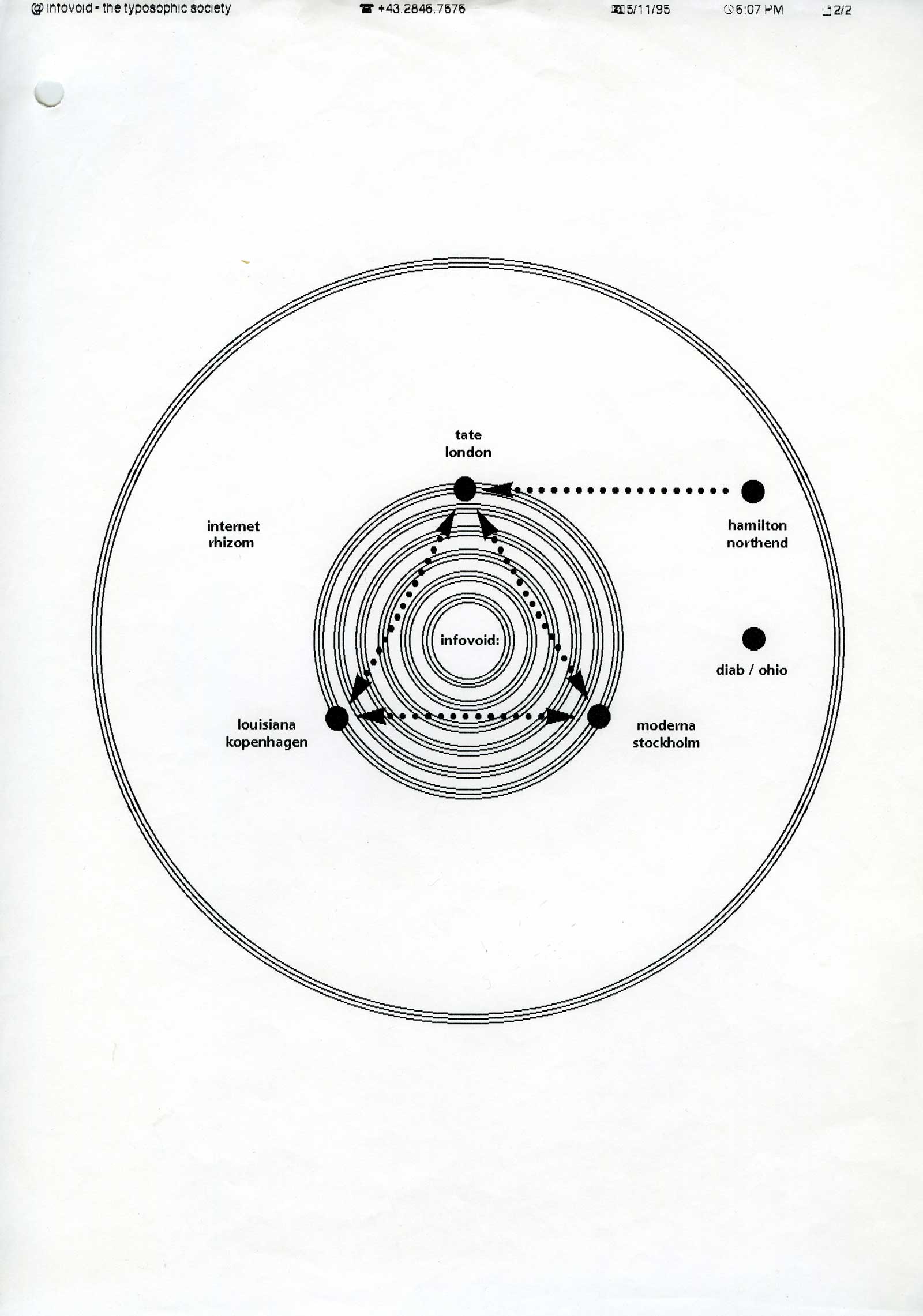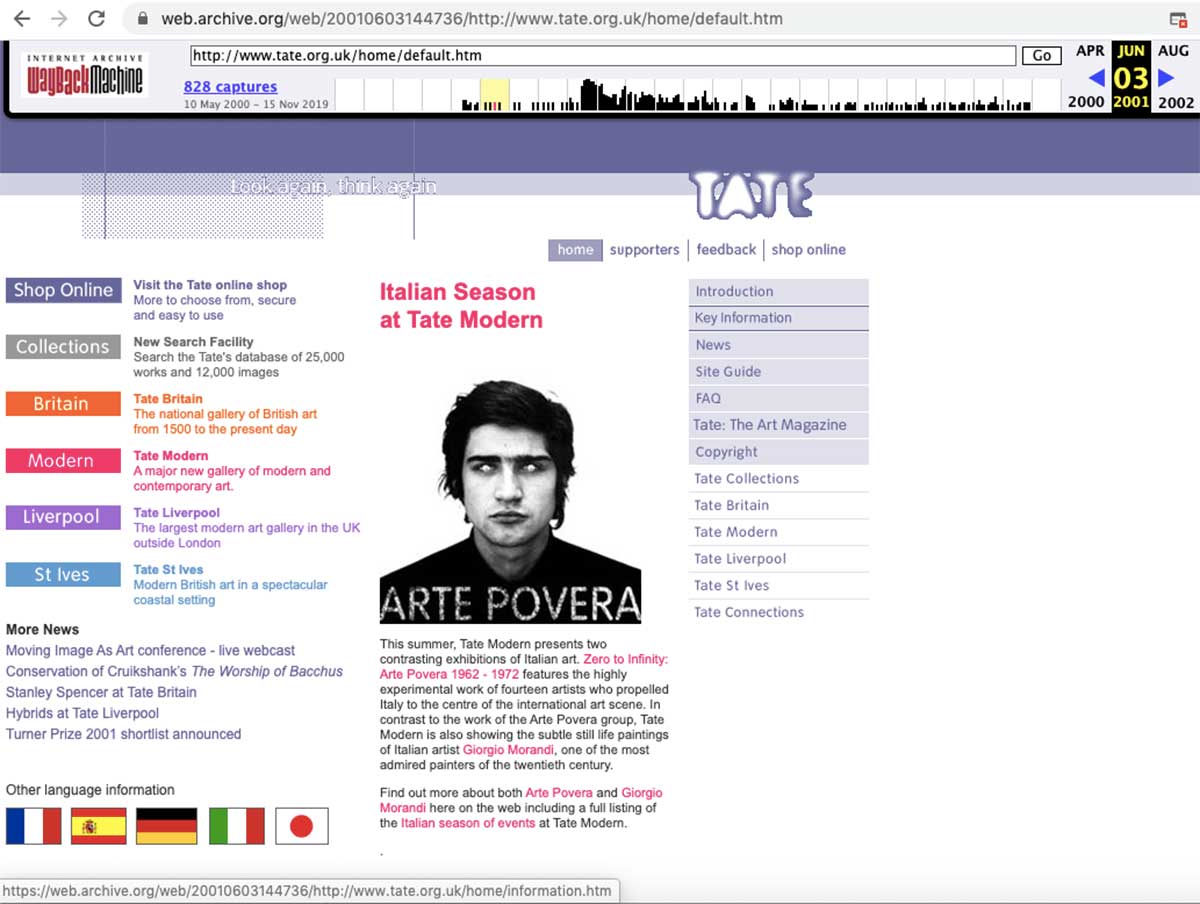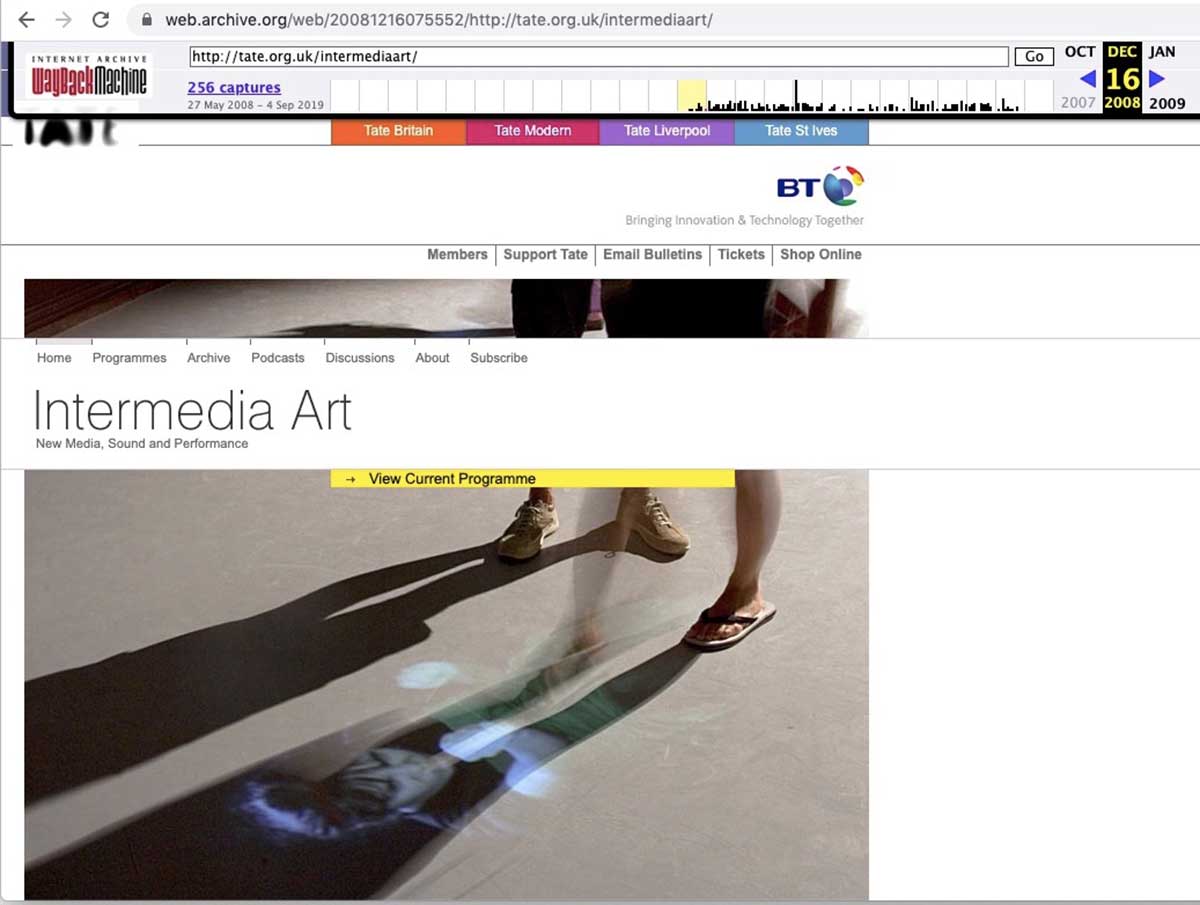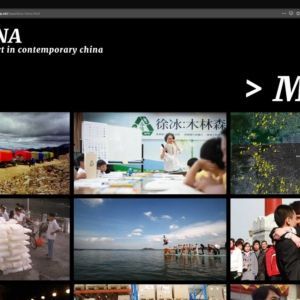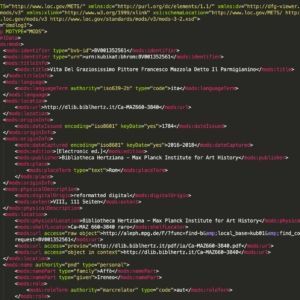Fig. 1. “The Internet – hypercube draft proposal,” Tate Acquisition file, Richard Hamilton (T07124 Diab DS-101 Computer, 1985–9) Tate Public Records, PC10.1, Tate Archive, Tate Britain.
Seep Between the Mortar: Sociotechnical Imaginaries in Digital Media at Tate
Lucy Bayley
Introduction
A computer sits in the stores, carefully boxed away after recently returning from exhibitions overseas. Distantly tied to the object is a “vanguard vision” of what might have been possible for the object, the museum, and the Web.[1] Diab DS-101 Computer is both a computer and an artwork.[2] It was created by Richard Hamilton after being invited by Ohio Scientific to create a minicomputer in 1983. What it eventually became evolved out of changes in technology between 1983 and 1989, as well as changes in the company (Ohio Scientific was bought by Diab, which was then bought by Bull Computing in 1990). It appears sculptural in an exhibition, but it had another imagined future. In 1994 Tate curators received a proposal in the post from Hamilton. Would they repurpose Diab and display it, not just as an artwork but also use it as the gallery’s internet server? This would mean that while on display visitors could interact with it, but it could also connect the museum to the internet. There was another element to the proposal. There were other versions of Diab DS-101 Computer: Hamilton had one in his studio in Northend (a village in Oxfordshire), there was one in the Louisiana Museum of Modern Art in Copenhagen, and one in the Moderna Museet, Stockholm. Hamilton proposed Tate connect all of these versions in the “infovoid” of the internet rhizome.[3] This repurposing of the artwork as an internet server or a meeting in the “infovoid” of different “Diab’s” never happened; it was too risky to place the museums’ infrastructure on a single artwork on display.
This is a story of an imagined future for museums and digital technologies. By recounting it here, I want to show the meeting point between a museum’s infrastructure, an artist proposal, and developing technologies. Hamilton’s imagined vision for his artwork, however egocentric, afforded the opportunity for conversations to take place between different practices in the museum that have been traditionally distinct. There were discussions between conservators, communications, IT, curators, and the director. One of the reasons this seemed possible was because it took place in the moment before Tate had either a website or an extensive digital infrastructure. Although not realized in the end, by raising the idea Hamilton posed a question about an artwork’s status and the possibility that an artwork might function or live differently in the museum. He imagined a possible connection between collection, museum, audiences, and the internet, and in doing so, brought different departments and practices together.
The moment in which Tate received Hamilton’s proposal, the mid-1990s, saw the arrival of the Web, as well as better software for digitizing collections; at this point there were new visions across arts, science, and technology for what digital media might offer museums. Projects and initiatives like the design or redesign of a website, new forms of digital storage, or changes in a cataloguing system bring science and technology in conversation with other areas of the institution: learning and curating, for example, or press, development, and communications departments. When digital projects in museums begin, technology is often pitched as a unifying force,[4] but as projects progress, earlier visions of collaborative working within the museum often fail to be fully embraced and instead expertise shifts back into disciplinary siloes. Yet, at the same time, there is a persistence of some of these imagined futures. In a project that utilizes digital media as a tool for documentation, why are some aspects “embedded” while others are not?[5] Where are the barriers and “stickiness” felt in a collaboration between different disciplines like ICT and curatorial?[6] Where and why does a collaboration between disciplines fail, or was some aspect of it flawed in the first place? What visions remain, and which ones persist?
In this paper, I use the theoretical framework of sociotechnical imaginaries to consider what persisted and what failed in digital media strategies at Tate between the mid-1990s and 2013. By digital media (a term adopted by Tate in 1999), I am referring to digitally based practices and technologies that are used by museums as a technological tool for documentation,[7] as a means to communicate and engage with audiences, and as an artistic medium.[8] Lev Manovich has referred to the attributes of digital media as “eclectic,” and its application in the 1990s as “unfortunate,” because it conflated computing with technology but only reflected on the idea of digitization. [9] This tends to exclude the role of “deeply social” software, the means through which digital media is experienced by users and gains its qualities.[10] The confusion that surrounds digital media can be found in early Tate strategy documents in the archive, as well as (a creative ambivalence) in artist proposals.
Sociotechnical narratives, as defined by Sheila Jasanoff, are “collectively held, institutionally stabilized, and publicly performed visions of desirable futures, animated by shared understandings of forms of social life and social order attainable through, and supportive of, advances in science and technology.”[11] Proposals by artists and designers of initiatives, like the launch of Tate’s website in 1998, were of course voiced by teams and imagined by individuals with an interest and knowledge in digital media, but they are also realized as a collective act and are the result of “social order[s].” As Jasanoff has pointed out, “Ideas matter in the origin stories of imaginaries…. But ideas about scientific and technological futures need to gain assent outside such bounded communities in order to become fully-fledged imaginaries. Often, they must latch onto tangible things that circulate and generate economic or social value…”[12] This theoretical frame offers a way to push against the traditional art historical or institutionalized impulse towards disciplined or “bounded” structures and instead enables space for an exploration of connection and reciprocity across disciplines, through visions and interstitial practices, including what was performed by science and technology.
Through sociotechnical imaginaries we see how “coproduction” takes places across epistemic practices, but also how this is often occluded from respective disciplines. In cultural and art historical accounts, with a few (but growing) exceptions, technological changes have rarely been accounted for.[13] This translates to the museum where, although there is coproduction and the “mutual emergence” of ideas between practices, the organizational structure and the hierarchy of practice reinforces a separation between departments. With coproduction in mind, I will reflect on some of Tate’s early digital projects and strategies, including the development of the website, and address how Tate’s digital strategy has been shaped and reshaped in relation to questions of access and inclusion by drawing on UK government policy. My examples are interwoven with a consideration of visions for digital media in the museum at the time, in order to make visible the actants in the collective process of realizing and extending an imaginary for digital.
I begin by situating my research and from here introduce the idea of access and inclusion from culture and politics in the UK in the 1990s, an agenda that should be understood as coproduced with the simultaneous development of digitization projects in museums. Some aspects of Tate’s website and its connected digital programmes are then brought to light, exploring its potentialities and failures. Finally, I explore the background of access in digital initiatives at Tate, ending with a comparison to the digital strategy in 2010, where the digital was framed as multidimensional, something we can see as the “post-digital” situation in museums.[14] In this focused case study, comparison, crucial for sociotechnical narratives, is approached historically by looking at the shift in digital vision and strategy at Tate between the mid-1990s and 2013.
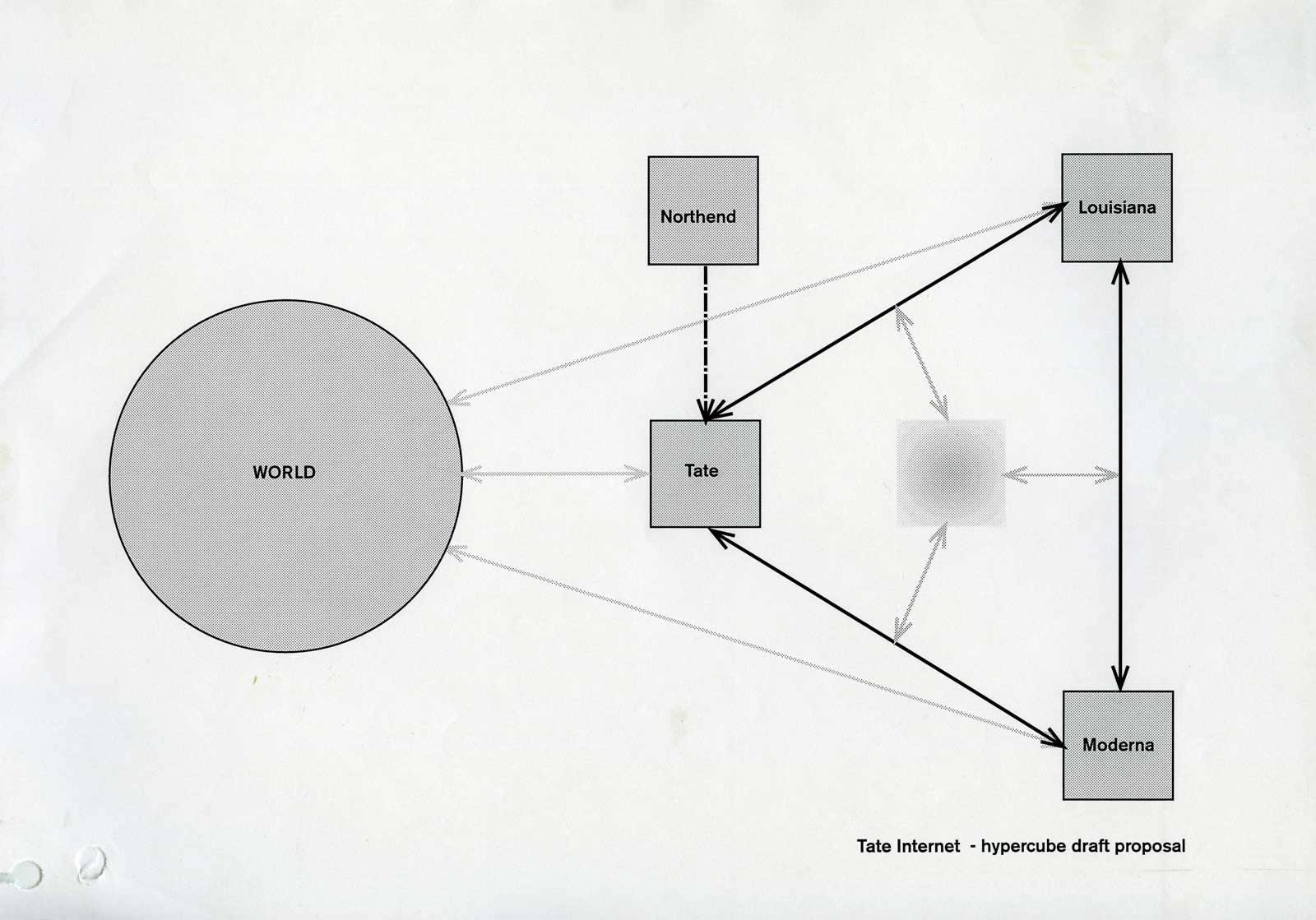
Fig. 2a. “The Internet – hypercube draft proposal,” Tate Acquisition file, Richard Hamilton (T07124 Diab DS-101 Computer, 1985–9) Tate Public Records, PC10.1, Tate Archive, Tate Britain.
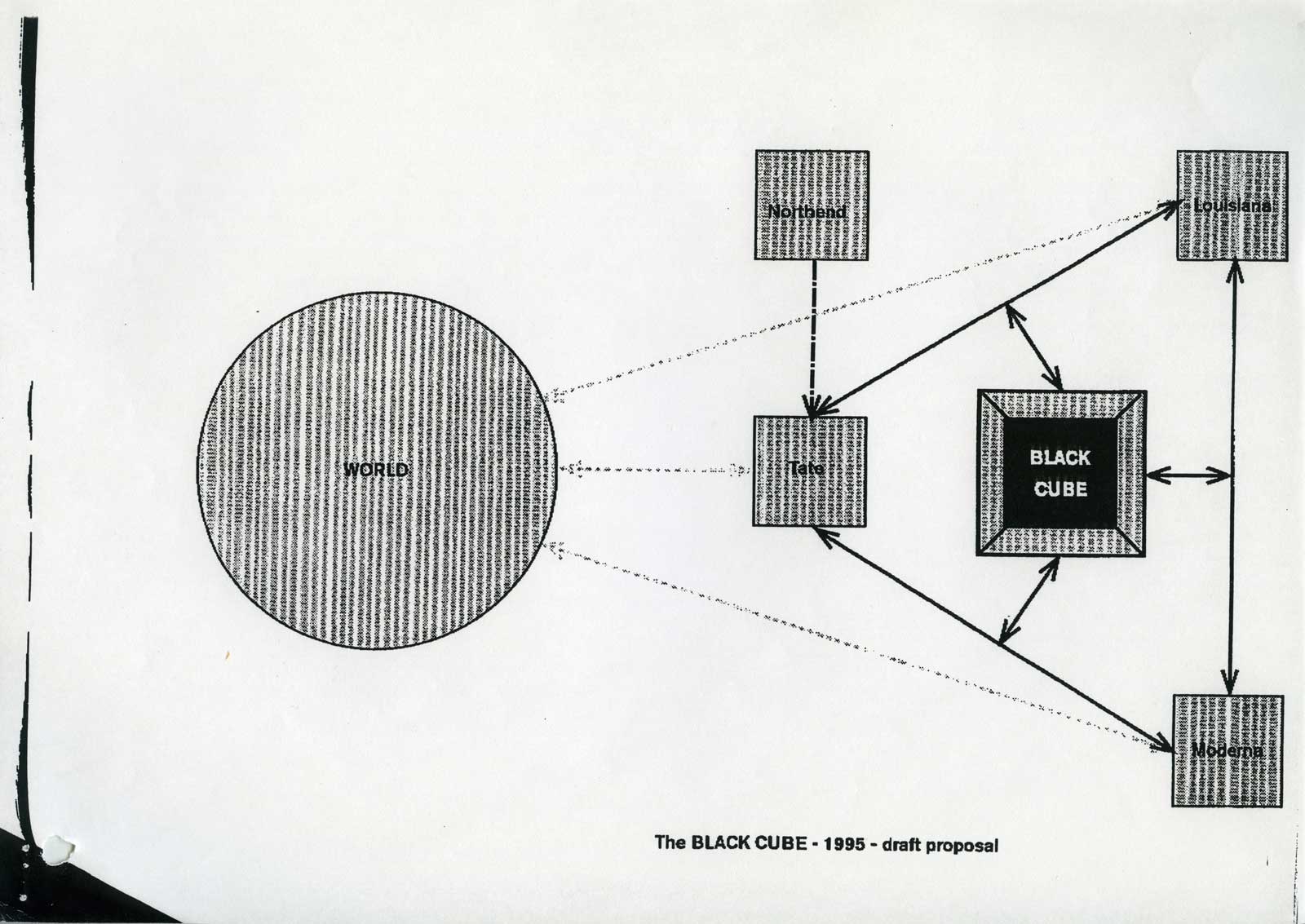
Fig. 2b. “The Internet – hypercube draft proposal,” Tate Acquisition file, Richard Hamilton (T07124 Diab DS-101 Computer, 1985–9) Tate Public Records, PC10.1, Tate Archive, Tate Britain.
Situating Research
My interest in the sociotechnical imaginaries of digital media has surfaced from my involvement in Reshaping the Collectible: When Artworks Live in the Museum. This project, funded by the Andrew W. Mellon Foundation and based in Collection Care Research at Tate, explores the lives of artworks in collections, in relation to changing artistic and museum practices.[15] The project looks at how an artwork unfolds over time; the blurred boundaries around how artworks, archives, and records are given a status and value—or not—in the collections. It considers ways of bringing the invisible lives of artworks into public view and addresses the potential for change in the museum, and where and why these changes might have occurred in the past. One of the six case studies was an examination of fifteen net artworks that were commissioned by Tate for the website between 2000 and 2011.[16] As part of this, the project explored communities of practice and the changing affordances of the internet between now and then. Working with teams across the organization, discussing the potential for change now and in the past, interviewing curators, artists, scientists, and technologists who worked on these commissions, and looking through the institution’s archives, I began to see the history of digital media at Tate as complex, hybrid, and socialized. I also saw how this potential has frequently come up against the organization’s hierarchies of knowledge.
Over ten years ago a research project called Tate Encounters: Britishness and Visual Culture took place at Tate Britain (2007–2010). The reflections that came from those involved on the hierarchy of knowledge and practice in the museum, and their decision to analyze the museum as and through distributive networks, has relevance for Reshaping the Collectible and this paper. The collaboration between Tate Britain, University of the Arts London, London South Bank University (LSBU), and LSBU students who came from a migrant family background was rooted in a “policy juncture” at Tate Britain around the “lack of attendance of ‘minority’ audiences.”[17] It explored the narratives of Britishness in Tate Britain’s collection and curatorial practices and how these were being received by different migrant and diasporic family members. In Tate Encounters, the lead researchers—Andrew Dewdney, David Dibosa, and Victoria Walsh—and their collaborators analyzed the relationship between art, culture, and society in connection with questions of global migration and new media ecologies. One of their reflections that is pertinent here is how “the potential of new media to recode and redistribute the cultural meaning of collections in the emerging practices of the art museum’s online presence comes up against an organizational hierarchy that arranges curatorial and editorial practices within the logic and status of accumulation of the collection.”[18] The authors are deliberate in their use of the term “new media,” because of the way it indicates the radical potential and major changes brought about through “human-computer interface.”[19] They propose we consider European museums as “distributive networks in which value travels along transmedial and transcultural lines” and encourage a recognition of the art museum as “part of both supply and demand, the production and consumption of art,” stating that, because of this, “it performs a complex set of mediation tasks in relaying cultural value.”[20]
The hierarchies of knowledge that researchers of Tate Encounters identify in the organization are arguably still present. In her research, Emily Pringle (Head of Research at Tate) has found that an institutional and an epistemological hierarchy still operates in museums; this is manifest in the way that “certain modes of knowledge and knowledge creation are advantaged over others.”[21] The curator of the collection is still conceived as “the legitimate producer of knowledge,” while “the knowledge of others in the museum” (i.e., conservation, collection care, learning, and digital) are “seen to be less vital to fulfilling the museum’s mission.”[22] Pringle articulates a general feeling in the museum that I have certainly experienced, but like Dewdney, Dibosa, and Walsh, I find that a stretching of institutional boundaries has taken place historically in conversations around digital media, perhaps because it has had such a complex evolution in the organization.
Imagining Access, 1997
In the 1990s a forceful imaginary for access and inclusion took hold in culture, education, and technology through a change in government policy in the UK. After New Labour was elected in 1997, the party implemented a long-term Labour pledge to tackle social exclusion.[23] For museums, arts organizations, libraries, and archives this included encouraging museums to remove admission charges by providing tax incentives; making collections more accessible through ICT and online access; creating new partnerships; consulting “people at risk of social exclusion”; and, more broadly, that museums, galleries, and archives should act as “agents for social change.”[24] The Social Exclusion Unit set up to address this commitment identified the following aim: “To promote the involvement in culture and leisure activities of those at risk of social disadvantage or marginalization, particularly by virtue of the area they live in; their disability, poverty, age, racial or ethnic origin. To improve the quality of people’s lives by these means.”[25]
In the UK, as elsewhere, the digitization drive in museums arrived at the same time and was seen as a way to democratize the knowledge of curators in institutions and, by doing this, help increase levels of inclusion in culture by providing simpler, remote access to information. A paper published by the UK’s Department for Culture Media and Sport (DCMS) in 2000 stated: “Museums, galleries and archives have a role to play in helping to exploit the new technologies to generate social cohesion and community involvement and participation, and to aid lifelong learning. They can do this by providing content and access to ICT, and by encouraging their buildings to be used as neutral meeting places.”[26] New sources of funding, like the Heritage Lottery’s Access Fund (set up in 1994 out of the newly established National Lottery), became available for digitization projects. Training was also rolled out from the Museums Training Institute (MTI) for museum professionals to promote industry-wide standards with new technologies.[27] At an international level, the ICOM’s (International Council of Museums) International Committee for Documentation (ICOM-CIDOC) and the Museum Documentation Association (MDA) led standards for digitization projects in the 1990s and 2000s.[28]
The social, personal, institutional, and environmental challenges that were identified by DCMS as barriers to accessing culture and education in museums, galleries, and archives included “low income and poverty,” “acquisition, exhibition and cataloguing policies which do not reflect the needs or interests of the actual or potential audiences,” and “difficult physical access into and within buildings.”[29] These barriers to inclusion, some of which had begun to be addressed by museums,[30] built on research emerging from the education, museums, and archives sectors.[31] Harder to pinpoint but vital to acknowledge is that they were deeply indebted to earlier political protests and campaigns. In Britain, for example, the growing commitment to diversity in the cultural sector in the 1990s was shaped in part by the challenges to cultural institutions of institutional racism and the need for equality made by individuals and groups in the 1970s and ’80s by, among others, Naseem Khan[32] and the Blk Art Group (1979–1984), both of whom had been working to create political transformation by bringing together artists and those leading cultural institutions.[33]
However, in New Labour’s cultural diversity policy there was a “slippage” from politics to policy and practice.[34] Although social inclusion agendas held democratic intentions, in their design and implementation by government, museums, libraries, and archives, there were fundamental flaws. What had earlier on been rooted in demands for structural change and a recognition of difference became translated into policies on diversity within multiculturalism as part of inclusion. One example of this in cultural organizations is the way that groups of people were targeted, and the success and failure of a project based on this criteria. From “blackness as a political position from which to critique power” it became a way for cultural organizations to “re-read… blackness as skin color.”[35] As Sara Ahmed puts it, the term diversity in policy “tends to be associated with race” and yet when used by institutions it often obscures this relationship and instead reproduces institutional whiteness.[36] In the shift from politics to policy, “cultural diversity became a way of avoiding political discussions about the need to differentiate power or the possibility of changing the direction of cultural flow,”[37] and as a result “it may produce no lasting transformation of knowledge, imagination or creative practice within the social body.”[38]
One example of this “slippage” can be found in the way that early digitization of Tate’s collection largely replicated what already existed in the collecting taxonomies. This happened while Tate Modern was in the process of opening; at the same moment, Tate Britain was also being redeveloped and the entire organization was going through a rebrand. These combined moments of institutional change, in the moment of the dot com boom, were built on a socio-technical imaginary for access and inclusion present at the time in culture, education, and politics.
New Sites: Tate Online, Tate Modern and Digital Programmes, 1998–2001
Between 1998 and 2000, through the British Art Information Project (supported by the Heritage Lottery Fund, HLF) 56,000 works from Tate’s collection and archives were digitally photographed and made available on the website.[39] The indexing was to be “devised from scratch” but would draw on “pre-existing public information index built up by the Information Desk in response to subject enquiries from gallery visitors” and “standard classification systems, such as ICONCLASS,” as well as other “subject-based retrieval” systems and “consultation with key Tate staff across a range of departments.”[40] Despite being pitched as a fresh start, the index, categories, terms, and search systems largely remained the same as their previous form, demonstrating how digital media “represents, and refracts, earlier representational techniques.”[41] For example, in the application to the HLF a number of ideas were scoped out for a glossary, which would provide richer information on works. The majority of what was proposed found its way into the current “Art and Artists” pages, such as captions (where information is compiled for display), catalogue texts, bibliographies, and links to art terms, but other areas did not. Narratives (“where a spoken account has been recorded in relation to a work”) and biographies of the contributor were proposed in the HLF application but not realized. More significantly, questions that could have been raised about the colonial origins in the museum’s cataloguing system, use of art historical terms, collecting categories, and language appear to have been mediated in part through education, interpretation, and to some extent interaction, but not through the taxonomy of the collection index system.
Some of these questions, raised but not interrogated in 1998, are beginning to be addressed.[42] One example of research into this area is “Provisional Semantics” a two-year research project led by Tate, Imperial War Museum, the National Trust and the University of the Arts London (one of nine foundational projects in Arts and Humanities Research Council funded initiative, Towards a National Collection). “Provisional Semantics” will look at how practices of cataloguing, subject indexing, and catalogue entries have been “informed by, and replicate, colonial contexts, attitudes and modes of perception.”[43] It will pay attention to the effects of these systems and practices on contemporary audiences, including people of African and Asian descent “whose diasporic histories are intertwined with Britain’s colonial past.”[44] The urgency today to address structural racism in cultural institutions and praxis in relation to digitization initiatives and infrastructure helps bring light to what was not interrogated at earlier stages, but instead remained as a persistent sociotechnical imaginary. If we look back to 1998, although an imaginary for access, inclusion and diversity appeared to be shared, not enough was interrogated and so, as the collection went online, politics slipped again and forms of exclusion remained.
While Tate Modern was in development, conversations about how the organization could be more strategic in its various digital projects, like the British Art Information Project (BAIP), were already taking place. In the Tate Archives, stapled together with the proposal for the BAIP, is a “Digital Media Strategy,” written in 1999 by Sandy Nairne (Director of National and International Programmes) and Vicki Porter (Consultant at Tate, 1997–1999). Here, the question of digital media, access, and diversity again collide.
Digital media can play a crucial role in fulfilling current ambitions—audience growth and diversity, documentation of the collection, increasing revenue, displaying new art, accessing Library and Archive materials, promoting learning and publication of research and educational materials—but only if there is a considered plan to do so.[45]
Digital media is seen here as an answer to a “desired future,” but audience growth and diversity is not unpacked and, like any sociotechnical imaginary, there was also “the obverse—shared fears of harms that might be incurred through invention and innovation and, of course the failure to innovate.”[46] For Tate, these included revenue, cross-departmental involvement (something that was beneficial but also challenging), and—in the background—the disconnect between Tate and audiences outside of London. Nairne and Porter’s thinking for the strategy was informed by the authors’ experiences and perspectives. Nairne had undertaken research into the use of interactive technologies in museums in North America in the early 1990s.[47] He had firsthand experience of access and diversity agendas in the arts since the 1980s and direct experience of Tate’s hierarchy, having worked as a researcher, curator, and registrar.[48] He was concerned about the reaction in the UK to another museum in London, and locating the Digital Programmes team within National and International Programmes was in part about addressing this concern. Also, in his mind were creative and critical responses to digital media and technologies by artists.

Fig. 5. Detail from Graham Harwood @ Mongrel, Uncomfortable Proximity, 2000. Commissioned for Tate’s website, this net artwork mirrored Tate’s website in design, but instead of an institutional rhetoric it included alternative information highlighting the stories of some of those oppressed by the gallery and the works in the collection.
[http://www2.tate.org.uk/netart/mongrel/home/default.htm]
Many aspects of the digital strategy were addressed; for one, an autonomous department was set up with individuals with art historical, curatorial, and digital expertise and, as they suggested, this team worked in a cross-departmental way.[49] This was inspired by other museums with “autonomous multimedia departments” headed by “a person who came from the content side but who had taken a special interest in communicating via digital media early on in their career.”[50] The cross-departmental approach of the Digital Programmes team had its advantages in terms of the risks that could be taken in programming, but in acting as a conduit between departments and disciplines they were also affected by the hierarchies of knowledge in the institution, which centralize the curator of the collection as “the legitimate producer of knowledge.”[51] We can see this through the experiences of those involved. For the first Head of Digital Programmes, Jemima Rellie, the position of the department within the broader institutional structure had its advantages:
We always operated slightly apart from curatorial. We would try and engage, and we did have some input. Sandy [Nairne] was, I would say, the biggest advocate and, in later days, Jessica Morgan became involved a bit. But I think, by and large, which, again, made it quite fun and, dare I say it, straightforward, we were allowed to get on with it.[52]
Kelli Dipple started as Webcasting Curator (replacing Honor Harger) and then moved to the position of Curator: Intermedia Art (2007–2011) within Tate Media. Though evidently restricted by the structures of the institution, Dipple found flexibility through dialogue, but also indicates the challenges.
The nature of the role means that it is as much about relationship management as it is about project management. And it’s very much about moving between departments and building trust and developing dialogue, and establishing relationships and understanding different sets of priorities, such that collectively something can be achieved that couldn’t be achieved independently within those departmental structures.[53]
Digital Programmes at Tate surfaced partly out of requirements of the media and partly from a legacy in education, as Dipple pointed out, the place where the “innovative stuff comes into the museum and seeps in-between the mortar.”[54] But, at the same time, there were limits to what could be achieved, because “you’re always juggling priorities” and when it is marginal to the museum’s main activities, you are often working with “limited resources.”[55] What is revealed through these situated perspectives is an experience of the contradictions in their roles and of the misperception of digital practices in the museum at the time.[56]
The term digital media is problematic because it conflates the “idea of digital coding” and the “idea of computation.”[57] Unlike “computer media” or “programmable media,” digital media does not reflect the way in which digital media itself operates with computation.[58] If we return to sociotechnical imaginaries, from the side of museums, digital was variable in its use and application, but from the perspective of science and technology what was being performed was the connection between commerce and culture, as its “economic and social value.”[59] Despite—or because of—the confusion that surrounded the term, it was increasingly used by arts organizations in the 1990s, because it usefully blurred the boundaries between digital programming as a curatorial activity, coding as a tool for the organization and management of digital assets, and the everyday use of the digital technology. This was a step towards a post-digital future of museums in which, Ross Parry suggests, “digital does not need to be recognized and championed separately in its own strategy,” because digitality has become normative in the museum’s vision; it has “enter[ed] the essential grammar and logic of these institutions.”[60] We can see this in the reshaping of the digital strategy, as addressed below.
Publishing Content, Losing Interaction, 2010–2013
The enacting of the imaginary for access and inclusion at Tate came together with the potential for financial enterprise. The appearance of museum websites coincided with the increasing privatization of the Web in the 1990s, as Katherine Jones-Garmil writes in The Wired Museum: “In the past two years we have seen corporate mergers and attempted mergers as private corporations scramble for a bigger share of the telecommunications pie.”[61] Like other museums, it was felt the Web would be a way for Tate to increase access to the collection, but also to create revenue through sponsorship, partnerships, and by increasingly acting as a “producer” of content.[62]
Between 2001 and 2013 there were continual shifts in the way that people working in Digital Programmes and Tate Media were structured at Tate. In 2002 Will Gompertz was appointed Head of the Department of Communication (replacing Damian Whitmore, who had led Tate’s rebranding). Gompertz introduced, among other things, Tate Shots in 2007 and “developed broadcasting facilities and established an in-house team that could support this new publishing role.”[63] He also built the Tate Media department. Marc Sands was appointed as Director of Audiences and Media, moving from a prominent role as Marketing Director at The Guardian in 2010. In the same year, John Stack, who was first Head of Online (2007–2013), then Head of Digital (2013–2015), published a digital strategy leading to the redesign of the website in 2012.[64]
This digital strategy proposed repositioning and redistributing the organization and management of digital practice and emphasized the distribution of authorship and knowledge. It included a proposal to use new models for learning and social media, and to place the collection at the center of the website; it emphasized the website’s “extensive and deep content” and proposed a model of financial sustainability, outlining how the management of content would be dispersed within the organization.[65] Tate Online would be “ideas-led and diverse through a proliferation of opinions, including multiple voices on the same subject, exchanging views”; “inclusive through content developed for audiences ranging from children to academics”; “international through incorporating multilingual elements, working online with curators and writers internationally, and engaging global audiences”; and stimulate two-way conversations.[66] This has echoes of the “Digital Media Strategy” from 1999,[67] but went further by integrating a knowledge of how digital media operates and aligning, as well as applying, this to the operations and communications in and outside the museum.
Many elements of Stack’s strategy were implemented and still apply. In 2013, however, in Stack’s new digital strategy, some aspects of the previous strategy were removed or diluted. There was a continued commitment to the pervasive quality of digital technology—it would be a “dimension of everything” at Tate—but authorship remained with the institution and interaction was controlled.[68] The potential for engagement with the public online had been tested out and found to be resource intensive. Ioanni Zouli has reflected on this as the paradoxical “meeting of aspirations” between Tate’s strategic plans and an invitation for an “online audience to participate, yet inside specific boundaries and towards pre-decided directions.”[69] What limits the possibility of free communication is a combination of “architecture of online spaces” and “the strategic decisions and the branding logic of the museum” on “institutional practices,” although it also has practical and financial considerations.[70] What is feasible within the museum’s resources? How much can an institution like Tate make space for the “unruliness” of online audiences and their potential for public critique?[71]
Conclusion
Tate’s digital programmes are an example of a sociotechnical imaginary of access and inclusion that pervaded culture, education, and politics in the UK throughout the 1990s. Transformations in digital technology successfully created new forms of collaboration between artists, publics, universities, software, and museums. This dispersal and visibility of previously hidden knowledge had been anticipated by the arrival of the digitization of museum collections. But, despite the extension of the imaginary for access and inclusion, a colonial bias remained in the structuring of digitized collections and is arguably still present, although hopefully beginning to be addressed. Difference and lived experience slipped away from politics to policy, and although acknowledged, it was not always critiqued in the structuring of digital systems.
The question of who has a voice and who can shape the issues that are being brought to light is starting to be discussed now, but the failure to address them at the time is important to acknowledge as evidence of where and how institutional blockages operate.[72] They can be found in the curatorial and artistic imaginaries and staff-written strategies for technological visions, as well as in the potentiality of e-commerce, broadcasting, and technology. Some of these have been recounted here, in order to make visible the actants in the collective process of realizing and extending an imaginary for digital.
Over the course of the various digital strategies, things got dropped. The extent of audience interaction, for example, at times diminished. But failures in digital strategies are often the ones that remain and persist. This is perhaps because of the distance between what one can imagine and what is actually possible within the technologies at the time. It is also about the extent to which ideas, terms, perspectives, systems, and practices are acknowledged and whether or not bias is addressed. Perhaps the problem is not to do with a disciplinary gap between culture, arts, and technology (as it often appears to be), but instead a result of the way technology performs and therefore what was imagined in the first place.
Access and inclusion, as well as the potential of feedback, interaction, and dialogue between perspectives and publics have remained persistent questions in shaping digital practice at Tate, as well as in museums more broadly. These have been informed by the increase in digital technologies, the arrival of the Web, and postcolonial debates in the early and mid-1990s; they also develop earlier reflections on information and the museum from the 1970s and ’80s.[73] Donna Haraway wrote, “If technology, like language, is a form of life, we cannot afford neutrality about its constitution and sustenance.”[74] This can be applied to digital infrastructures in museums. Details that were not addressed, such as the structuring and cataloguing of information, for example, and the assumption of neutral technologies, are now being considered with greater urgency, but it will be equally important to reflect on what begins to slip away in the process.
